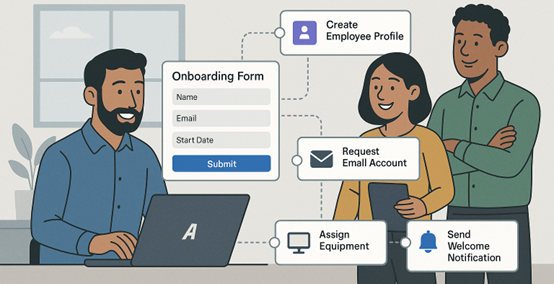Appian: The Anti-Operational Chaos
Operational complexity has become a silent force holding back organizations’ growth potential.
By Role
By Industry
By Target Customer
What We Offer
We drive business growth by improving operational efficiency through process optimization, smart automation, and cost control. Our approach boosts productivity, reduces expenses, and increases profitability with scalable, sustainable solutions
Customer Experience
We design memorable, customer-centered experiences that drive loyalty, enhance support, and optimize every stage of the journey. From maturity frameworks and experience maps to loyalty programs, service design, and feedback analysis, we help brands deeply connect with users and grow sustainably.
Marketing & Sales
We drive marketing and sales strategies that combine technology, creativity, and analytics to accelerate growth. From value proposition design and AI-driven automation to inbound, ABM, and sales enablement strategies, we help businesses attract, convert, and retain customers effectively and profitably.
Pricing & Revenue
We optimize pricing and revenue through data-driven strategies and integrated planning. From profitability modeling and margin analysis to demand management and sales forecasting, we help maximize financial performance and business competitiveness.
Digital Transformation
We accelerate digital transformation by aligning strategy, processes and technology. From operating model definition and intelligent automation to CRM implementation, artificial intelligence and digital channels, we help organizations adapt, scale and lead in changing and competitive environments.
Operational Efficiency
We enhance operational efficiency through process optimization, intelligent automation, and cost control. From cost reduction strategies and process redesign to RPA and value analysis, we help businesses boost productivity, agility, and sustainable profitability.
Customer Experience
Marketing & Sales
Pricing & Revenue
Digital Transformation
Operational Efficiency
6 min read
Por Daniel Zapata | Oct 24, 2025
6 min read
Por Daniel Zapata | Oct 24, 2025
In many organizations, processes flow across teams with distinct objectives: marketing generates opportunities, sales negotiates deals, operations execute them, and customer service closes the loop with support or follow-up. Yet, throughout these stages, genuine connection often gets lost. Systems don’t communicate, data is duplicated or lost, and each department ends up “making do” with spreadsheets or emails just to keep things moving forward.
On the surface, it might appear that everything works harmoniously. However, this lack of integration is actually hindering growth. When information fails to flow, teams operate on assumptions, decisions are made too late, and opportunities slip away.
That’s where Appian comes in—a low-code platform that unifies people, data, and processes within a single workflow. It bridges the fragmented elements of your operations, bringing coherence to what once seemed impossible to automate.
Appian was not created to replace existing systems—it was built to connect them. In many organizations, strategic initiatives stall at the critical transition from “we should do this” to “it’s already operational.” Between these two phases lies a gap that neither the best plan nor any software, on its own, can fully bridge.
This is precisely where Appian proves invaluable. Rather than acting as just another tool in the ecosystem, it serves as the bridge connecting business logic to seamless operational execution. Appian transforms processes, requests, workflows, or decisions into actionable, visible, and automatable steps—without requiring a wholesale overhaul of your technology environment.
When a leader envisions a new workflow, IT teams can build it in Appian in a matter of days, enabling business users to adopt it almost immediately. This ability to “think and execute without friction” makes Appian a true catalyst for transformation.
Appian doesn’t compete with your current systems—it harmonizes them. It integrates data from your CRM, business rules from your ERP, and approvals from internal portals, turning fragmented operations into a unified enterprise that moves in sync.
Every organization speaks multiple languages: CFOs focus on margins, COOs drive efficiency, IT ensures infrastructure, and service teams aim for rapid resolution. Appian serves as an interpreter among them, enabling the design of workflows that cross departments and systems, maintaining centralized control and reliable data throughout.
Appian was not created for a specific type of user. Its true power is that every level within an organization can leverage it differently, without friction between people, systems and processes.
When a company adopts Appian, it is not just implementing a technology, but a new way of operating. From strategic leaders to field teams, everyone gains something different... but everyone connects to the same flow. Let's see it clearly:
Executives measure success not by the number of tasks completed, but by the business’s ability to respond swiftly to change. Imagine María Solís, CEO of the financial services company Credivia, preparing to launch an innovative green credit product. The concept is solid, but a traditional rollout would require months of coordination between marketing, risk, operations, and technology.
With Appian, Credivia can model the entire process—from application to approval and disbursement—through a visual interface. Each department contributes its own rules and steps, yet the entire workflow is built and tested in just days. Once the campaign goes live, the CEO can monitor real-time performance: tracking incoming applications, approvals, and pinpointing bottlenecks in the process.
What once took months and scattered spreadsheets now unfolds on a platform that turns decisions into immediate action.
CFO → real-time cost control
COO → seamless execution without rework
CEO → strategy delivered at market speed
Managers live between the pressure of results and technological dependence.
Let's take the case of Daniel Mora, Human Resources manager in an industrial company called Mecatron. Every time he hires someone, he must coordinate with five areas: legal, finance, technology, security and operations.
Before, this involved email chains, shared sheets and constant calls to confirm who had approved what.

With Appian, Daniel and his team create an automated onboarding flow.
The onboarding form automatically feeds all the systems involved: it creates the employee's profile in HR, requests the email account, assigns the physical equipment and sends a welcome notification.
Nothing is lost, nothing is repeated. Each manager receives his or her task at the exact moment it is due to him or her.
The next time a new employee arrives, Daniel doesn't have to "chase" approvals. The process flows by itself, and he can concentrate on what's important: the employee experience.
While managers focus on process flows, IT teams concentrate on architecture, integrations, and governance. Appian offers them a rare combination: a platform where they can act with agility without compromising security or technical quality.
Take the example of Lucía Brenes, IT leader at the regional logistics company Transvida. Her challenge was formidable: to connect a sales CRM, a financial ERP, and a shipment tracking portal—three systems that did not communicate with each other. With Appian, Lucía and her team created a single interface that pulls data from all three systems and presents it on one dashboard. Billing, delivery confirmation, and collection flows are now automated and synchronized in seconds.
The outcomes extended beyond the technical: business users no longer need to access three separate platforms, reporting accuracy has improved, and the IT team has gained valuable time to focus on innovation instead of maintenance.
In practice, it’s operational teams who experience the most immediate impact of successful automation. They’re the ones who make things happen: approving, processing, servicing, coordinating, verifying, and executing daily operations.
Thanks to Appian’s low-code approach, many Business Process that once required technical support can now be configured using intuitive visual tools that are easy to understand and maintain. This empowers operational teams to actively participate in building or enhancing their own workflows, without being fully dependent on the IT department.
>> What is a Low-Code Platform and Why Does It Matter? <<
Tasks that previously relied on emails, spreadsheets, or phone calls are now integrated into streamlined digital flows, eliminating unnecessary steps and reducing manual errors. Operational teams can leverage Appian to:
- Manage work orders or internal requests without lengthy email chains.
- Automate approvals and validations, such as permissions, purchase requests, or inventory controls.
- Synchronize data between multiple systems without re-entering the same information.
- Centralize real-time case or incident tracking with clear dashboards and automated alerts.
- Coordinate deliveries, maintenance, reports, or field services through a single interface.
Low-code doesn’t just accelerate automation—it democratizes continuous improvement. Appian doesn’t replace the value of operational work; it frees teams from bottlenecks, providing greater visibility and allowing people to focus on the tasks that require true human judgment.
>> Does Appian replace your existing systems or enhance them? <<
Appian is inherently cross-functional. Its low-code flexibility enables it to adapt to virtually any operating model. Here are just a few of the industries already leveraging its capabilities worldwide:
Financial Services & Banking: Credit management, digital onboarding, regulatory compliance, audits, operational risk.
Insurance: Claims processing, policy evaluation, incident response, document validation.
Healthcare & Pharmaceuticals: Patient management, clinical trial oversight, regulatory approvals, medical supply chain management.
Energy & Utilities: Asset management, operations monitoring, predictive maintenance, service requests.
Manufacturing: Quality control, production management, work orders, component traceability.
Logistics & Transportation: Shipment tracking, fleet management, delivery coordination, inventory control.
Retail & Consumer Goods: Store operations, vendor management, stock replenishment, returns.
Telecommunications: Service activation, customer management, automated support and claims.
Education: Enrollment administration, academic management, student and faculty tracking.
Public Sector & Government: Digital services, case management, licensing, transparency, citizen services.
Construction & Real Estate: Project oversight, document management, permitting, contractor coordination.
Technology & Professional Services: Project management, deliverables tracking, internal workflow automation.
And the list continues to grow. In any sector where processes, data, and teams must collaborate, Appian creates real efficiency.
Appian is not just for developers or executives: it's for organizations determined to move forward with coherence. As a platform, it integrates enterprise systems and aligns them to work at the same pace, turning strategy into action and those actions into reliable data for better decision-making.
Whether you need to accelerate customer response, connect internal systems, or reduce your team's manual workload, Appian makes it possible. This is more than a technical promise—it's about enabling business fluidity.
Appian isn’t reserved for process architects or IT experts. It's designed to unite C-level strategic vision with operational execution across the organization. From CEOs seeking efficiency and control, to analysts aiming to eliminate repetitive tasks and reclaim time, Appian acts as a digital fabric that brings the organization together under one operating model. This cross-functionality positions the platform as a catalyst for transformation, both technological and cultural.
Appian’s real value emerges when every level of the organization adopts a continuous improvement mindset. Executives monitor critical KPIs in real time from dashboards, area leaders spot bottlenecks and optimize workflows without relying on traditional development, while operations teams automate tasks and scale processes with full control and traceability. This unique balance between autonomy and governance separates those who simply digitize from those who truly transform how they operate.
Ultimately, Appian should be embraced by any organization looking to reduce friction between strategy and execution, eliminate silos, and boost business agility without sacrificing visibility. The question is no longer “who can use Appian,” but “how much value is lost by not using it.” Organizations that understand this don’t just automate—they design intelligent, adaptive operations built for sustainable performance.
Ready to see how your organization can work smarter with Appian? Contact ICX Consulting to discover how we can help drive automation at every level of your business, with a strategy engineered for intelligent growth.

Operational complexity has become a silent force holding back organizations’ growth potential.

Process Mining has emerged as a revolutionary tool in business process management and optimization, representing a significant leap from traditional...

When a company decides to implement a platform like Appian, it typically faces a strategic question: is it about replacing what already exists, or...